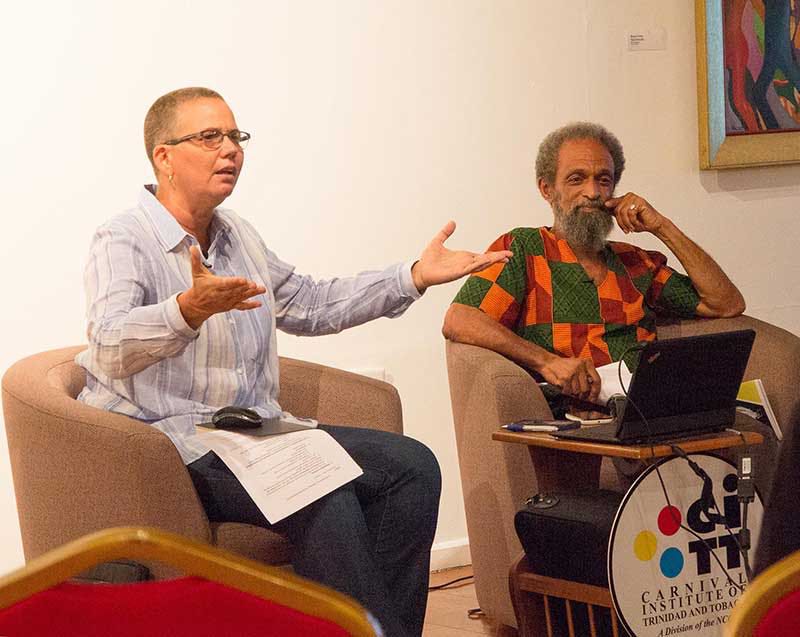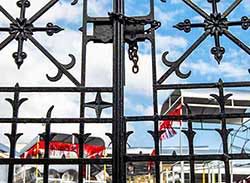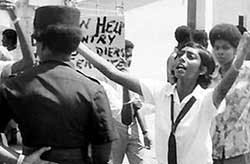Nunes, Mutope consider their role as witnesses
02/09/17 15:24 Filed in: Reporting

Maria Nunes and Apoesho Mutope discuss their work at the National Library’s August Lecture. Photo by Mark Lyndersay. Click to enlarge thumbnails below
At Saturday’s conversation about documentary photography by image makers Maria Nunes and Apoesho Mutope, Confessions of a Witness: Photo/Memory/Identity, some considerations were raised by the panelists while others arose from their deliberations on the state of the craft in T&T.
The photographers considered the role of the documentary photographer, “To see,” as Maria Nunes said, “on behalf of others.”
In documenting, Apoesho Mutope spoke of the need to choose where photographs are taken from, making the decision to photograph from a distance with longer lenses as a more remote observer or with wider lenses with a perspective much closer to the action.
He spoke of his experiences in 1985 when a protest turned violent outside the Oval and of his own coverage of that event, one in which the late Guardian photographer Noel Saldenha found himself battered by being too close to the action.
Nunes spoke of her own choices in selecting among bands to cover in 2009 and the decision to work with Desperadoes, chosen because of their status as a refugee band, unable to practice in their own camp.
“I wanted to be a witness to that displacement,” she said.
For Nunes that observation included witnessing the complexities of the band’s separation from its home and moving into space after space over the years since.
“And part of that witnessing is seeing the relationship grow between the band and new arranger, Clive Zanda.”
“My work,” Nunes explained, “is about working out issues of cultural identity in modern T&T. Our festivals are what help us to have a national identity.”
Apoesho Mutope’s first exhibition was in 2011 in the Annex of the National Museum, and he recalls being asked by artist Makemba Kunle whether his work was documentary or art.
”I’d never considered it before,“ Mutope said.
Recalling his start as a documentarian, Mutope described himself as ”A young boy, just trying to get started in photography, and then 1970 happened.“
He recalled with a sadness that still seemed fresh, the first eight rolls he shot of the Black Power Revolution that he passed along to a colleague when the police came calling, who passed it along to someone else.
He tried tracking the canisters down after he was released from Nelson Island, ”but I never saw them again.“
While it may have been an artist’s choice, it seemed poignant that while Nunes offered up dozens of images, Mutope showed just 15 photographs of rich historical value, but fragile quality if judged strictly as photographs.
”They aren’t great pictures,“ he cautioned, ”but they are important ones.“
And so they are.
In one photograph, shot at one of NJAC’s nightly meetings at Woodford Square, Makandal Daaga is an indistinct blur, almost cut off at the right of the frame, looking out at hundreds of expectant, curious faces, the rich black hues of their skin fading in the distance into the obsidian darkness of the night.
In another, taken on the first day of the trial of the army mutineers, a remarkable tableau plays out.
Girl children in their school uniforms demonstrate with placards before an implacable policewoman, her back to the camera, as Josanne Leonard, also in uniform raises her hands in defiance at the officer.
Another girl, her head bouffant with a full afro, stands insouciantly in the distance with her hand on her hips, looking at the confrontation.
Mutope is working on a book that chronicles his work from the seventies.
”There are a lot of pictures I don’t have, but there must be a record of it.“
”There is a need for history to acknowledge that it [the Revolution] happened. We have to do it, because nobody else ain’t doing it.“
blog comments powered by Disqus

